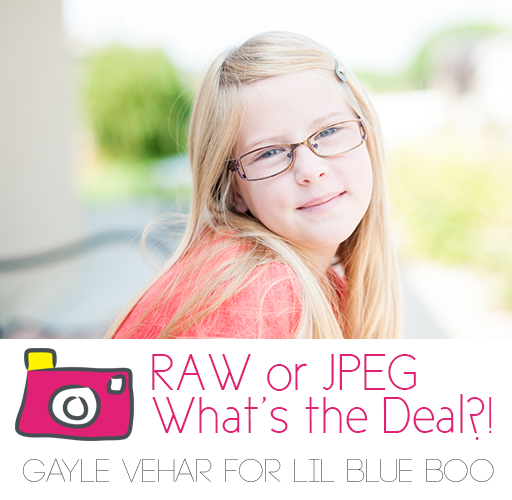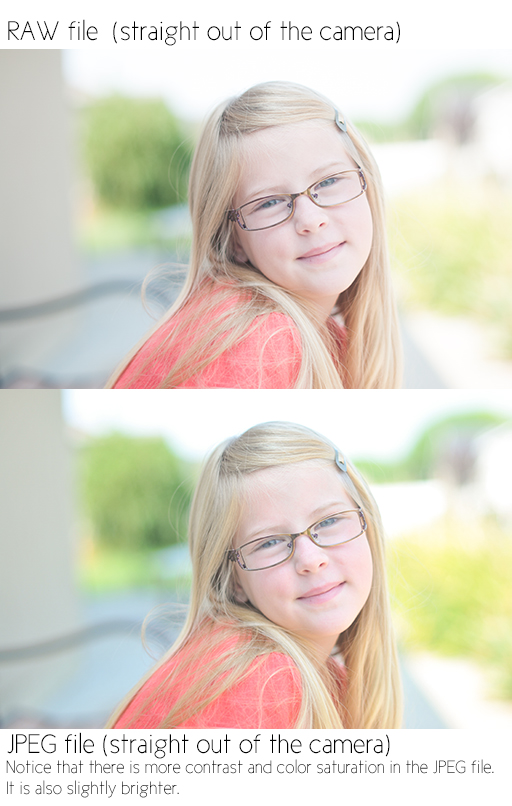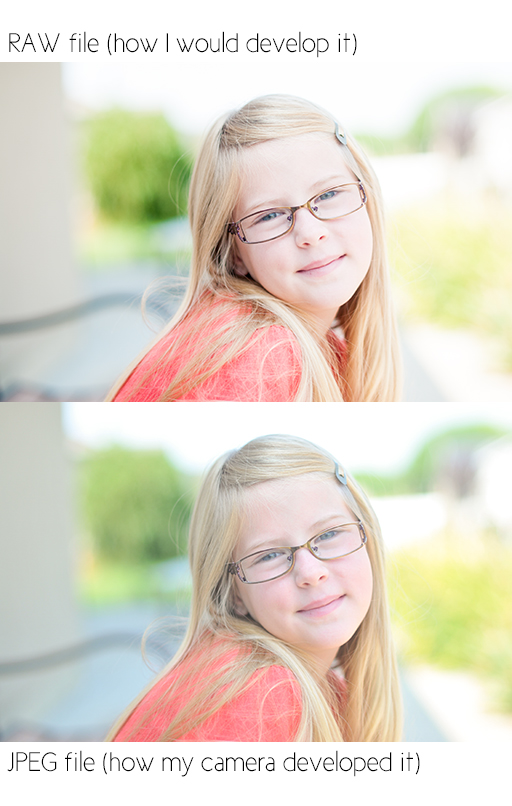
If you have a digital camera, chances are good that you have heard these two terms—or maybe even read about them in your camera manual. Most point and shoot camera’s now have the option to use the RAW file format.
Today, I am not planning to try to persuade you one way or the other, just give you an overview of them both and the reasons why you should or shouldn’t use them.
JPEG
JPEG is likely what your camera is set on right now if you haven’t ever thought about or changed this setting. JPEGs are a universal file format. This means that this is a file type that most everyone can view or print.
All JPEG files are compressed in camera. They are compressed various amounts depending on the setting that you choose. Large (or Fine in Nikon terms) JPEGs are compressed less than Small (Basic) JPEGs. Because the files are more compressed they take up less room on your hard drive and more shots can fit on a memory card.
JPEGs have processing applied in camera according to your camera manufacturer’s specifications. It is ready to be printed or shared on the web just the way it is.
JPEG files can be edited. However, JPEGs degrade quickly with editing. Adobe Lightroom and Adobe Camera RAW (part of Photoshop) are a bit of an exception to this.

RAW
RAW is probably not the setting that your camera will come on from the factory. RAW files are the largest file your camera can produce. They have the most information saved in them because they haven’t been compressed or processed by your camera at all.
These files are dull looking when they come out of the camera, but contain a lot of dynamic range that is a treasure when you are developing your photos with your favorite software.
These files are proprietary to your camera manufacturer. This means that they are NOT a standard format that can be viewed by everyone straight out of the camera. You’ll need special software to view them on your computer (usually provided by your camera manufacturer or by most good/professional editing software.)
You’ll also need to convert them to a JPEG file before sending them off to be printed.
RAW files contain the most information your camera can store in a file. Because RAW files contain so much more information than JPEG files, they can tolerate much more editing/developing than a standard JPEG. All the information that they contain also allows them to be much more forgiving when you are editing a photo that is underexposed or overexposed.

When to Use Each One
Use JPEG if you have no desire to develop your photos and just want to be able to share them straight out of the camera or with only simple editing. MAKE SURE you have your camera set to record the largest JPEG file it can. If you use only the smallest JPEG your photos will only be suitable for sharing online or for very small prints. You never know when you are going to capture that “favorite” photo so give yourself as many options to begin with as possible (and memory cards are cheap!!)
Use RAW if you want to be in control of the developing of your photos and are willing to go to a bit of extra work to get the results you want. I started shooting RAW when I was just learning digital and have LOVED it. It gave me a lot of options in the beginning when I was taking lots of bad exposures. RAW files also forced me to learn how to develop my photos the way I wanted.


Thank you this was so helpful!
I have never shot in RAW before (a little intimidated). I also only have a netbook right now so editing is quite a chore. Excited to try it though when I have a computer more suited for photo editing!
Thank you !!! Very well explained, very helpful !!!
I’d love to shoot in RAW but 1) it IS intimidating and 2) I take SO many pics at any given time I’m afraid I’d never get ten all edited (and that I wouldn’t know how)
Start by shooting in RAW+JPEG for a month. That way you have the JPEG files but can experiment with RAW editing, too!
I know I ‘need’ to shoot in RAW but am intimated/frustrated by not being able to look at them all on my computer quickly. I guess I need software that would convert them so I can view them before editing. I have a Canon 7D and use CS5 for editing. Suggestions?
Sharon, you can download Adobe Camera Raw off of Adobe’s website then directly import your Raw file from there into CS. Also your camera should have come with software you could install on your computer that allows you to view all of your files quickly and easily! 🙂 I have a tendency to quickly flip through my files in Zoombrowser which came with my Canon DSLR.
I will look at those. I guess my work flow issue is that I don’t bring everything into CS.
Thanks!
Lightroom.. That is my suggestion.
OR If you need something less expensive, Google’s Picasa 3 will read Canon’s RAW file format, and it is free.
I shoot raw because I like to mess around with it in Lightroom. I also feel like, I have this awesome camera, I want more artistic license. some of my relatives get frustrated because I then go home and spend time getting them back to them, but I think it is better in the end.
My Nikon D7000 has the option of shooting RAW + jpeg. It takes more space on my memory card, but I love that I CAN see the pics right away to sort out the keepers (using the jpeg files) but if I WANT to play with them, the option is there.
Thanks for the informative post!
I do the same thing. Takes us more space, but I’ve got an 8GB memory card, so it takes a fair amount of photos. If I’m worried about space, I tend to switch back and forth. For example, I was on a tour that was part on the bus. Through the window, the pics weren’t going to be great no matter what I did with them, so I only shot them in jpeg, but when I got off the bus, I switched to both. It takes a little bit of work and memory, but it works for me.
If I’m just messing with pictures in iPhoto, should I just keep using jpegs? Is it only worth trying RAW if I’m going to be using a more advanced software after?
I think you could use either with iPhoto. How much are you editing your photos? Do you like the results?
In the battle between JPEG vs RAW this tee hold a secret message. Can you see it?
http://pinterest.com/pin/3096293464125671/
I always use JPEG and Lightroom for all editing. Just wondering if prints would come out with better quality if I use RAW?
That was very help full. But I do have one more question. My camera software(used to get pics off the camera) asks me if I want to import JPEG,RAW, or both? So does this mean that my camera is storing both on its own? I’m definitely goin to start importing and using my RAW. I love editing my pictures and this explains why when I “over” edit them they never print nicely, they are no mean for that. I’ve not loved my camera. I let the guy talk me out of a canon for a different higher end point and shoot. But now armed with this info maybe I will learn to love my camera.
Thanks again.
It might be taking both if you have it set that way. Check to see if you have RAW+jpeg turned on. Otherwise it is just recording one or the other. I have seen wonderful pictures come out of point and shoots as well. I bet if you get to know your camera and it’s capabilities you can get wonderful pictures with it!
Love this information, especially with have 5 kids…I try to take all our family photos.
Hello…If after the fact that a RAW file has to be converted back to JPEG, what is the point???? Arent you still going to loose critical info detail afterward!!! Please answer!!!!
Yes. When you convert you will lose some info. However, there is so much info in a RAW file that while you are developing it there is more info to work with when trying to fix an image (overexposed, underexposed) and typically edits to a RAW photo in an editor like Lightroom or Photoshop are non-destructive. I love starting from a RAW photo, but everyone does it different and you can get great results with a JPEG, too!